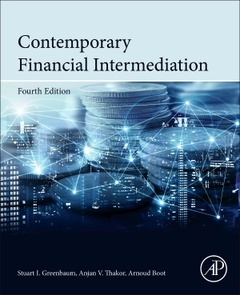Description
Contemporary Financial Intermediation (4th Ed.)
Authors: Greenbaum Stuart I., Thakor Anjan V., Boot Arnoud W. A.
Language: English
Subject for Contemporary Financial Intermediation:
Keywords
Aggregopathies; NDP52; P62; SQSTM1; Ubiquitin-proteasome system
126.84 €
In Print (Delivery period: 14 days).
Add to cart490 p. · 21.4x27.6 cm · Hardback
Description
/li>Contents
/li>Readership
/li>Biography
/li>Comment
/li>
Contemporary Financial Intermediation, 4th Edition by Greenbaum, Thakor, and Boot continues to offer a distinctive approach to the study of financial markets and institutions by presenting an integrated portrait that puts information and economic reasoning at the core. Instead of primarily naming and describing markets, regulations, and institutions as is common, Contemporary Financial Intermediation explores the subtlety, plasticity and fragility of financial institutions and credit markets. In this new edition every chapter has been updated and pedagogical supplements have been enhanced. For the financial sector, the best preprofessional training explains the reasons why markets, institutions, and regulators evolve they do, why we suffer recurring financial crises occur and how we typically react to them. Our textbook demands more in terms of quantitative skills and analysis, but its ability to teach about the forces shaping the financial world is unmatched.
Part I. The Background Chapter 1. Basic Concepts
Part II. What is Financial Intermediation? Chapter 2. The Nature and Variety of Financial IntermediationChapter 3. The What, How, and Why of Financial Intermediaries
Part III. Identification and Management of Major Banking Risks Chapter 4. Bank RisksChapter 5. Interest Rate RiskChapter 6. Liquidity Risk
Part IV. “On Balance Sheet Banking Activities Chapter 7. Spot Lending and Credit RiskChapter 8. Further Issues in Bank LendinChapter 9. Special Topics in Credit: Syndicated Loans, Loan Sales, and Project Finance
Part V. Off the Bank’s Balance Sheet Chapter 10. Off-Balance Sheet Banking and Contingent Claims ProductsChapter 11. Securitization
Part VI. The Funding of the Bank Chapter 12. The Deposit Contract, Deposit Insurance, and Shadow BankingChapter 13. Bank Capital Structure
Part VII. Financial Crises Chapter 14. The 2007–2009 Financial Crisis and Other Financial Crises
Part VIII. Bank Regulation Chapter 15. Objectives of Bank RegulationChapter 16. Milestones in Banking Legislation and Regulatory Reform
Part IX. Financial Innovation Chapter 17. The Evolution of Banks and Markets and the Role of Financial Innovation
Part X. The Future Chapter 18. The Future
As the John E. Simon Professor of Finance and Senior Associate Dean of Programs at the Olin School of Business, Washington University, St. Louis, Anjan Thakor works in both academia and the business world. Prior to joining the Olin School, he was Edward J. Frey Professor of Banking and Finance at the Ross School of Business, University of Michigan, where he also served as chairman of the Finance area. He has worked with many companies, including Whirlpool Corporation, Allision Engine Co., Citigroup, RR Donnelley, Dana Corporation, Anheuser-Busch, Zenith Corporation, Lincoln National Corporation, and J.P. Morgan.
Arnoud Boot is professor of Corporate Finance and Financial Markets at the University of Amsterdam and chairman of the European Finance Association (EFA). He is chairman of the Bank Council of the Dutch Central Bank (DNB), member of the Scientific Council for Government Policy (WRR) and member of the Royal Netherlands Academy of Arts and Sciences (KNAW). He is also a research fellow at the Centre for Economic Policy Research (CEPR) in London.
Prior to his current positions, he was a member of the Inaugural Advisory Committee of the European Systemic Risk Board (ESRB), partner in the Finance and Strategy Practice at McKinsey & Co. and a faculty member at the J.L. Kellogg Graduate School of Management at Northwestern University in Chicago. He was also Bertil Danielsson Visiting
- Updates and expands a legacy title in a valuable field
- Holds a prominent position in a growing portfolio of finance textbooks
- Teaches tactics on how to recognize and forecast fluctuations in financial markets




